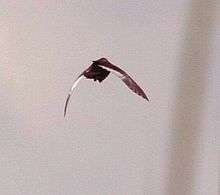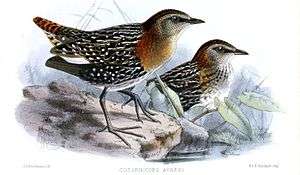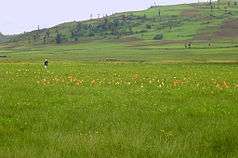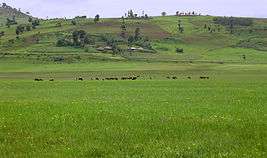White-winged flufftail
| White-winged flufftail | |
|---|---|
 | |
| In Mpumalanga, South Africa | |
| Scientific classification | |
| Kingdom: | Animalia |
| Phylum: | Chordata |
| Class: | Aves |
| Order: | Gruiformes |
| Family: | Rallidae |
| Genus: | Sarothruridae |
| Species: | S. ayresi |
| Binomial name | |
| Sarothrura ayresi (Gurney, 1877) | |
| Synonyms | |
| |
The white-winged flufftail (Sarothrura ayresi) is a very rare African bird in the Sarothruridae family. Its scientific name honours South African ornithologist Thomas Ayres, who discovered it at Potchefstroom.[n 1]
Description
It resembles its relatives in the flufftail genus, but both sexes have dull plumage and dark crowns. In flight both sexes also show distinctive white secondary feathers, a feature shared only with the related genus Coturnicops.
Distribution and habitat
The species has a seemingly disjunct range, being found north of the equator in Ethiopia, and south of it in Zambia, Zimbabwe and South Africa. The only breeding records are from highland marshes of central Ethiopia. It is a very local, and apparently only summer, visitor to highland marshes south of the equator. It is unknown whether the northern and southern populations are distinct, but their physical features appear identical. The birds are not resident in any of the few known sites, sometimes departing after as little as six weeks when conditions turn unfavourable.
The three Ethiopian sites are the Suluta Valley wetlands, the Berga wetlands and the Wersebi wetlands near Addis Ababa. The species was first found to breed at the Berga wetlands in 1997. Breeding has since been confirmed from the Wersebi wetlands and the Bilacha river wetland, close to Berga, which may be the main site. In South Africa they are regular at the Dullstroom and Wakkerstroom marshes, where public access is strictly regulated.
Non-breeding birds call only at dawn and dusk, sometimes in duet. Their natural habitat is seasonal marshland of subtropical or tropical high-altitude grassland. The species is severely threatened by habitat loss, causes of which include grass trampling by cattle, grass cutting and drainage of swamps for pasture. Regulated land management could improve the situation markedly.
Gallery



Notes
- ↑ The once extensive Potchefstroom marshes have since been reduced to small remnants. See: Sam de Beer (2001), Nick Jonas (2004) Potchefstroom and environs
References
- ↑ BirdLife International (2013). "Sarothrura ayresi". IUCN Red List of Threatened Species. Version 2013.2. International Union for Conservation of Nature. Retrieved 26 November 2013.
- Taylor, B., van Perlo, B. (1998) Rails. Pica Press, pp. 68–69, 172-175. ISBN 90-74345-20-4
- Local conservation group discover new flufftail site, 15 December 2005
External links
- Species Factsheet, BirdLife
- Berga Wetland Important Bird Area, BirdLife website
- Report on species conservation workshop, June 2008, BirdLife
- White-winged flufftail - Species text in The Atlas of Southern African Birds.
